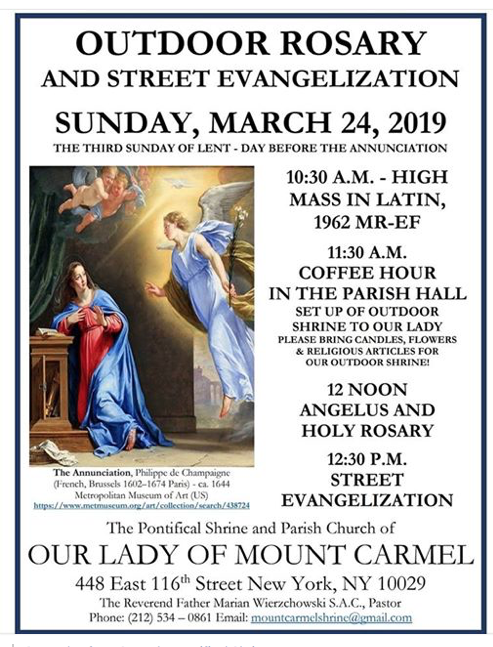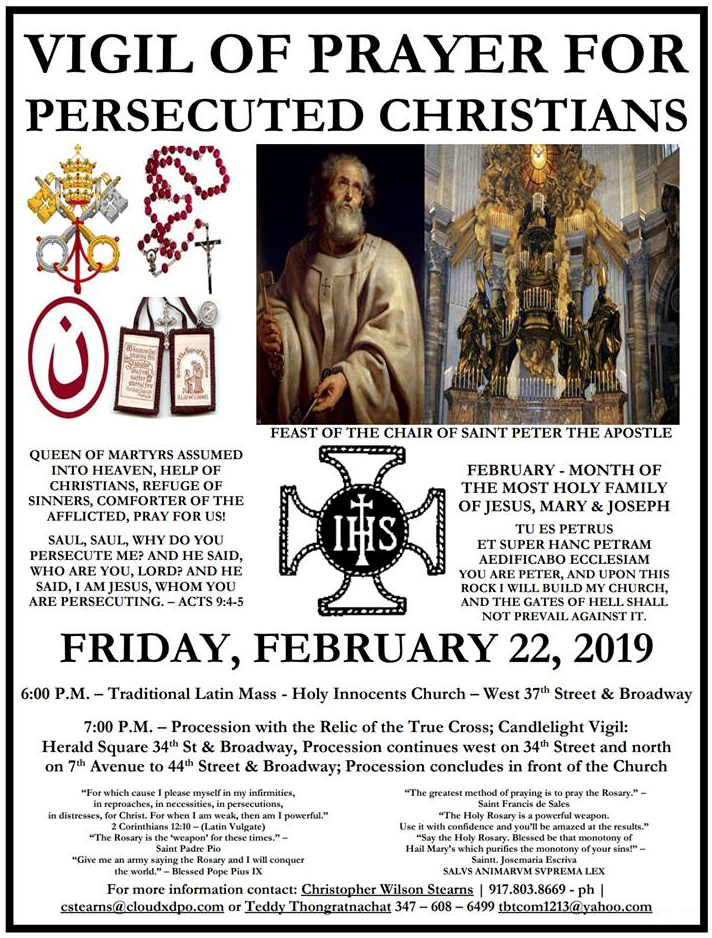
22
Feb

20
Feb
Holy Redeemer, Freeport, Solemn High Mass, Sunday, March 3rd at 5pm
Women’s Retreat – February 28th is the last day to register! *Father is looking for a young man (17 or older) to help out with serving for the weekend (please contact danmarengo@aol.com if interested)*
March 15-17 at the Seminary of the Immaculate Conception, Huntington
Fr. John Perricone, retreat master – Includes daily Latin Masses!
Sunday, March 17th following the 9am Latin Mass at St. Ladislaus, Hempstead
Young Adult Latin Mass and Social
St. Matthew, Dix Hills
Thursday, March 21st at 7pm
Sunday, April 7th following the 9am Latin Mass at St. Ladislaus, Hempstead
St. Josaphat, Bayside – Lenten calendar:
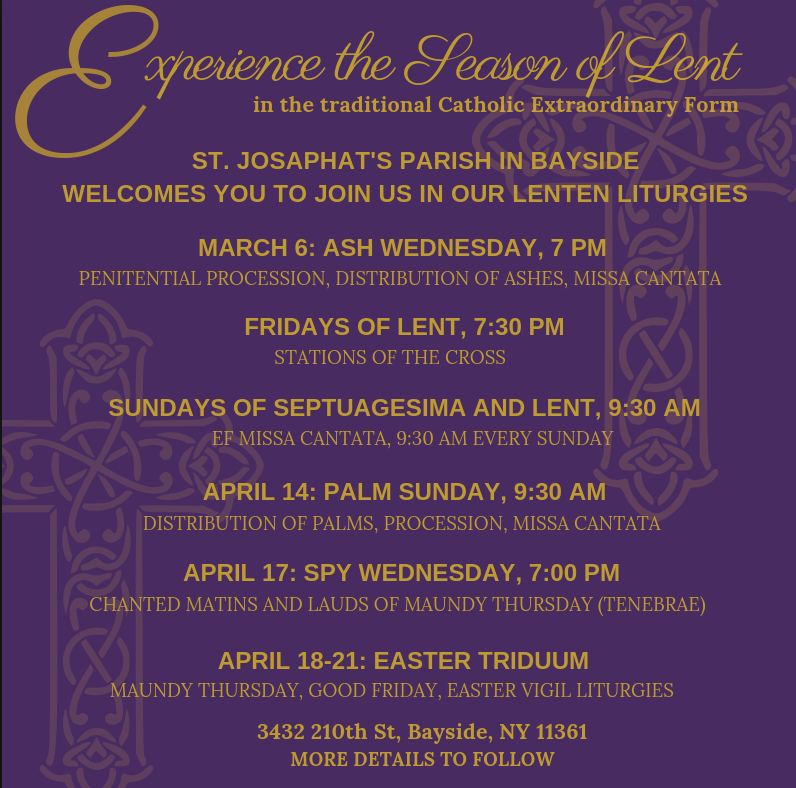
20
Feb
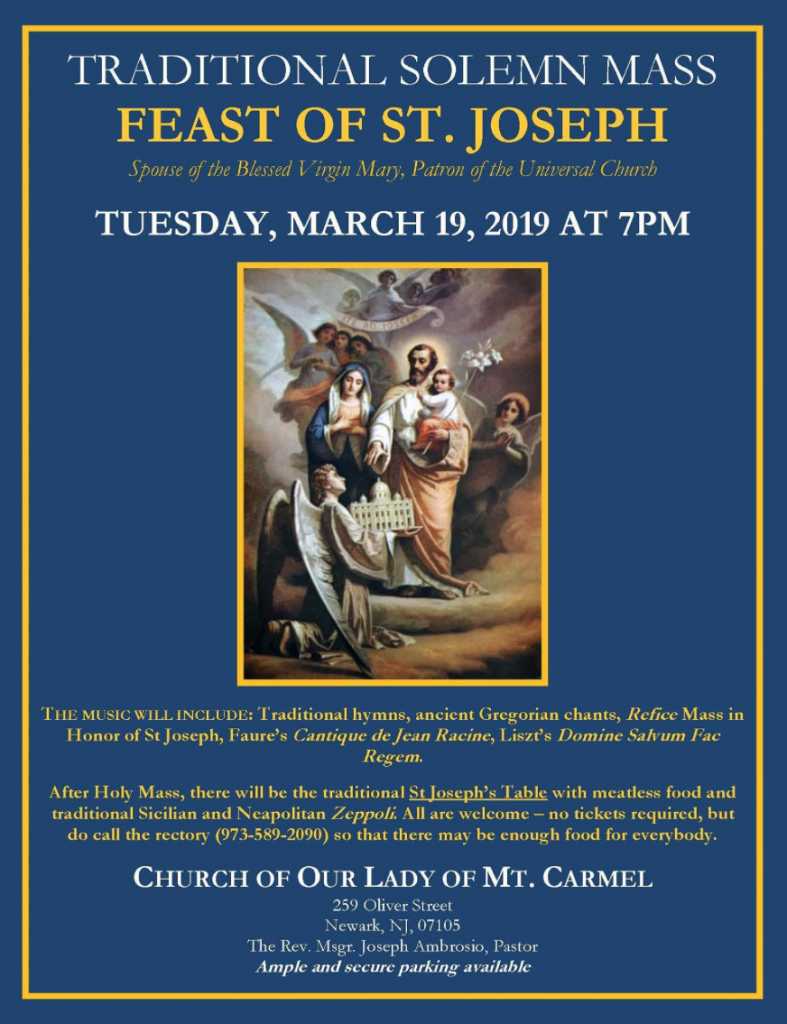
Our Lady of Mount Carmel Church in Newark will be celebrating a Solemn High Mass for the Feast of St Joseph on Tuesday, March 19, 2019 at 7:00pm.
The celebrant will be Rev Msgr. Joseph F. Ambrosio, Pastor
Deacon will be the Fr. Richard Cipolla
Subdeacon will be Dr. Thomas Rossi.
The music will be as follows: Traditional hymns, ancient Gregorian chants, choral music of Refice, Faure and Liszt (Refice Mass in Honor of St Joseph, Faure’s Cantique de Jean Racine, Liszt Domine Salvum Fac Regem)
The address is 259 Oliver Street Newark NJ 07105. Ample and secure parking. After mass there will be a traditional St Joseph’s Table with meatless food and traditional Sicilian and Neapolitan St Joseph’s Zeopples. All are welcome, no tickets are required but do call the rectory so that there is enough food 973-589-2090.
20
Feb
18
Feb
Peter A. Kwasniewski
(Lecture delivered at St. Mary’s parish, Norwalk, CT, on Thursday, February 14)
Repetition in the liturgy is a profound topic, and I am under no illusions that I will be able to offer a comprehensive or definitive account of it. Rather, I would like to suggest some ways of thinking about repetition that may help us to appreciate its positive value, over against the assumptions that stood behind the far-reaching simplification of liturgical rites in the 20thcentury.
First, I will look at a symptomatic text in the Second Vatican Council; second, I will explore the psychological value of repetition; third, I will examine formal repetition in a sacred context and use the Confiteor as my case study; fourth, I will consider whether there is room for improvement in the old rite of Mass; finally, I will discuss certain temptations that arise with repetition, and thus come to my conclusion.
A weak link in Sacrosanctum Concilium’s chain
Among the worst casualties of the liturgical reform were prayers and gestures in the Mass that were judged to be instances of “useless repetition,” such as the doubled Confiteor, the ninefold Kyrie,the threefold Domine, non sum dignus,and the genuflections and signs of the cross in the Roman Canon. Such purgings were said to have been done in fulfillment of the criteria given in paragraph 50 of the Constitution on the Sacred Liturgy Sacrosanctum Concilium:
The rite of the Mass is to be revised in such a way that the intrinsic nature and purpose of its several parts, as also the connection between them, may be more clearly manifested, and that devout and active participation by the faithful may be more easily achieved. For this purpose the rites are to be simplified [simpliciores fiant], due care being taken to preserve their substance [substantia]; elements which, with the passage of time, came to be duplicated, or were added with but little advantage, are now to be discarded; other elements which have suffered injury through accidents of history are now to be restored to the vigor which they had in the days of the holy Fathers, as may seem useful or necessary.[1]
The dictates in this paragraph rest on more universal principles enunciated in paragraph 34:
The rites should be distinguished by a noble simplicity; they should be short, clear, and unencumbered by useless repetitions; they should be within the people’s powers of comprehension, and normally should not require much explanation.[2]
We might note, first, that this is a rather poor translation of the Latin[3]—affording us yet another example of why a fresh and more accurate English edition of the conciliar documents is desperately overdue:
The rites should shine forth with a noble simplicity; they should be clear in brevity, avoid unprofitable repetitions, and be accommodated to the faithful’s capacity; nor should they generally require many explanations.
While this rendering makes the text not quite so heavy-handed, it is still, regrettably, one of the weaker statements in the Constitution, as can be seen from five angles.
First, what exactly is meant by “simplicity”? The simplicity of God is actually infinite and pre-inclusive of all things; the simplicity of prime matter is potentially infinite and totally indefinite; the simplicity of a saint is bound to look strange to the world; the simplicity of a child is easily taken advantage of. Adding the qualifier “noble” helps only a little.
Second, that rites be brevitate perspicui,“clear in [their] brevity,” raises a host of questions left unanswered: why should we think that a ritual enactment of an unfathomable mystery could ever be transparent to the eyes of body or of soul? Why should we think that conciseness would help, rather than hinder, our assimilation of this mystery?[4] Aidan Nichols writes: “To the sociologist, it is by no means self-evident that brief, clear rites have greater transformative potential than complex, abundant, lavish, rich, long rites, furnished with elaborate ceremonial.”[5] The Eastern tradition works on the opposite assumption, namely, that leisurely length, waves of repetition, and a certain obscurity are essential to the liturgy—a fact to which Pope John Paul II bore witness when he wrote, concerning the Byzantine liturgy: “The lengthy duration of the celebrations, the repeated invocations, everything expresses gradual identification with the mystery celebrated with one’s whole person”[6]—and the same may be said of the Western tradition at its best. Art historians love to speak of the chiaroscuroof Baroque painters, but the painters are not the inventors of this approach to light and darkness. The liturgy is the chiaroscuro of the divine mysteries, which shine forth with a light far too bright for our intellects to comprehend.
Third, that rites should “avoid unprofitable repetition” leaves one scratching one’s head. If we are speaking about senseless babbling, like a broken record or a scratched compact disc, who could disagree, and why would it need to be said at all? On the other hand, verbal repetition is one of the most common literary devices found in Scripture (“Amen, amen, I say to you”[7]), in the world’s great poetry (“Quoth the Raven ‘Nevermore’”[8]), in popular devotions (the Rosary, litanies, novenas), and in all liturgies (e.g., dozens of “Lord have mercy’s” in the Divine Liturgy of St. John Chrysostom), so the criterion can also come across sounding uneducated or, worse, ideological.
A meaningless repetition of elements is rightly avoided as irrational. How different is the chanting of the Litany of the Saints or the Litany of Loreto, the Paters and Aves counted on the beads of a well-loved rosary, or the cascading Kyries of a Byzantine Divine Liturgy! Of such insistent pleading, it is Our Lord himself who offered the definitive example in the Garden of Gethsemane: “He left them again, and went away and prayed a third time, saying the same thing once more” (Mt 26:44; cf. Mk 14:39).[9]
The conciliar text, in its far-from-clear brevity, does not specify when repetition is useful and when it is not, nor what the criteria of utility might be. There is no hint of awareness that emphasizing the concept of usefulness might betray a utilitarianism at odds with deeper considerations of spirituality, aesthetics, and tradition.
Fourth, the statement that rites ought to be “accommodated to the faithful’s capacity” is totally unhelpful. Are “the faithful” an undifferentiated homogeneous mass? Some are well-catechized, others are ignorant; some are new to the Faith, others lifelong devotees; some are inclined to contemplative prayer, others are extroverts who find it hard to quiet down and concentrate; some are avid readers of Guéranger’s Liturgical Year, others have barely taken notice of the Liturgical Movement’s existence. There is no way to succeed in creating a liturgical rite aimed at an ill-defined or indefinable “capacity of the faithful.”[10] It is the faithfulwhose diverse capacities must be accommodated to the liturgy’s immense reality, not the liturgy that must be retooled and refashioned to suit an imaginary congregation. As we know, the default assumption later on was that liturgy should be accommodated to the lowest denominator, that is, the Catholic who knows almost nothing, makes no effort to cultivate his interior life, and, consequently, needs to be constantly animated from without.
Fifth, the requirement that liturgical rites should not “generally require many explanations” is baffling in light of paragraph 34’s call for simplification. A rite is communicative to the extent that it is permeated with signs or symbols, and thus one might believe that the more densely symbolic it is, and the more numerous and pronounced its gestures, and the richer its prayers, the more powerfully it will be able to communicate to a receptive soul—and precisely without the need for many explanations. But if a rite is too obvious, too brief, too straightforward, and too stripped down, it will take a huge amount of explanation to persuade people that something important, numinous, transformative, or miraculous is happening. If one wishes to avoid a lot of verbal explanations before, during, and after the liturgy, one has to protect the liturgy’s own inherent language of vestments, manipulatives, places, postures, gestures, chants, orations, and silences.
Sometimes one wonders howSacrosanctum Concilium might have been written, if its authors had been altar card-carrying members of Roman Catholicism who had harnessed the insights of anthropology, psychology, and theology. Let’s imagine how paragraph 34 in particular could have sounded:
The rites should shine forth with the beauty of a unified complexity that mirrors the infinite simplicity of God and the ordered multiplicity of His creation. They should combine clarity and obscurity, length and brevity; they should cultivate meaningful repetition, accentuate symbolic objects and actions, and eschew verbal explanations. To the faithful who seek holiness, the rites should offer a lifelong apprenticeship in the Church’s prayer of adoration, contrition, supplication, and thanksgiving.
In other words, the rites should be the traditional Western rites that the Church already had, most notably the Roman Rite. There was no need to “improve” them; rather, the deformations that had occurred under Pope Pius XII, above all the massacre of Holy Week, should have been undone.
In any case, paragraph 34 is what it is, and must stand or fall on its own merits.
One interesting detail I should like to mention is that the draft of Sacrosanctum Concilium examined by the Central Preparatory Commission says not inutiles but ineptas: that “repetitiones ineptas” should be avoided. According to Lewis and Short, ineptas means “inept, unsuitable, tasteless, absurd.”It was the Rev. Augustin-Joseph Antoine Sépinski, O.F.M., Minister General of the Order of Friars Minor, who suggested the change to inutiles.[11]Was this small change made in order to smooth the path for those on the Commission who wanted to do away with, for example, the ninefold Kyrie? It would be very difficult, after all, to argue that a repetition like that was “inept, unsuitable, tasteless, absurd,” but easier to argue that it ought to be suppressed or trimmed back because it is “useless, unserviceable, unprofitable” (as the Lewis and Short translates inutiles).
Why was it even thought necessary to ask for a removal of repetitions? Where did the negative attitude come from? Let me offer as an illustration the following passage from Romano Guardini’s famous and influential book The Spirit of the Liturgy(1918):
The justification of methods of prayer such as, e.g., the Rosary, must not be gainsaid. They have a necessary and peculiar effect in the spiritual life. They clearly express the difference which exists between liturgical and popular prayer. The liturgy has for its fundamental principle, Ne bis idem [never the same thing twice]. It aims at a continuous progress of ideas, mood, and intention. Popular devotion, on the contrary, has a strongly contemplative character, and loves to linger around a few simple images, ideas, and moods without any swift changes of thought. For the people the forms of devotion are often merely a means of being with God. On this account they love repetition. The ever-renewed requests of the Our Father, Hail Mary, etc., are for them at the same time receptacles into which they can pour their hearts.[12]
This is an odd thing for a man of Guardini’s stature to say, for surely he knew thatallliturgical prayer in East and West includes repetition, no less than he knew that popular devotions involve progression, as in the mysteries of the Rosary, the versicles of the Angelus, or the Stations of the Cross. Moreover, the characteristic he attributes to popular devotion, namely, that it has a contemplative character, can just as readily be attributed to the liturgy, especially in the Western sphere. Perhaps it was this kind of dichotomous thinking that stood behind the campaign againstrepetitiones inutiles.
Members of the Liturgical Movement often praised the “objectivity” of liturgy and sleighted the “subjectivism” of devotion. While there is some truth to this contrast, there is also a tendency to oversimplification if we forget the way in which the sphere of liturgy is so grand in its objectivity that it makes room for an almost endless subjective involvement of the faithful, and at the same time, that Catholic devotions at their best possess a rock-solid dogmatic core and lend themselves to, or inspire the creation of, quasi-liturgical literary and artistic forms. One might think of the many musical compositions, some of them truly great, that have been inspired by the Stations of the Cross, and served as food for meditation in the popular paraliturgies of Good Friday.
The psychological value of repetition
We need to ask ourselves deeper questions than the authors of Sacrosanctum Concilium evidently did. What is repetition all about? When and why it is used in human life and in worship? We should seek an answer at both the natural level, that is, as regards universal human psychology, and at the supernatural level, in connection with the rituals of the Christian religion.
We repeat things for several distinct reasons, as can be seen by looking, with St. Thomas Aquinas, at the different faculties of the soul.
In regard to the faculty of the intellect and our capacity for understanding, we repeat for the sake of further penetration. Since men do not have angelic intellects capable of immediately grasping a truth in its totality, we benefit from repeated encounters with a statement or an object, for each time it is possible we might catch a new glimpse of it, like (to use a well-worn metaphor) an observer walking around a statue, seeing it from different angles.[13] Moreover, liturgical repetition is usually bound up with numerological symbolism, which makes an appeal to the intellect, establishing a connection between whatever it is we are saying and a larger, more encompassing mystery to which it alludes. Thus, the ninefold Kyrieat the start of Mass is a doubly underlined Trinitarian prayer: three petitions addressed to the Father, three to the Son, and three to the Holy Ghost.
Closely related to this intellectual aspect is the value of repetition for filling the imagination and shaping the memory. That which is repeated is more continually present to our inner sensorium, thereby making a deeper impression on our faculty of memory. It is obvious that we must repeat something if we are to memorize it, or, in that wonderful idiom, “learn it by heart.”[14] If we want prayer to move from our intellect to our heart, it must become familiar, internalized, habitual, and connatural, so that we are not expending our energy on the more superficial activity of navigating new phrases, new sentiments, new patterns. It doesn’t do me any good to be surrounded by thousands of books if I have none of their content in my soul.[15] It is when the Church’s words given to me from without become mywords rooted within that the liturgy becomes, in fact, the font and apex of myChristian life. Anyamount of repetition will help in this regard, even if it is as minimal as it often is with the new Liturgy of the Hours, where some psalms are said only once a month. Far more helpful in acquiring that connaturality with prayer is daily and weekly repetition, and so, in a different way, is the straightforward verbal repetition of saying the same thing multiple times in a row, provided that one does so conscientiously and not with a wandering mind.
I would add here that the very forming of words on the lips, whether we utter the words out loud or mouth them sotto voce, is a crucial part of this process of informing the memory. In The Love of Learning and the Desire for God, Jean Leclercq reminds us that medieval monks rarely read silently; they saw reading as an act of ruminating or chewing on the words, savoring their distinctive sounds, as if words were already incipient music. Reading, in short, involved “muscle memory.” Just as it is well known from experience and scientific studies that singing facilitates textual memorization far better than mere reciting does, and that rhymed and metered poems are easier to memorize than prose, it is also well known that making words with one’s lips inscribes them more firmly on the tablet of the soul than silently passing our eyes over them. What I have said about the lips may be said about any part of the body that is subject to the control of our will, such as our head, fingers, arms, and legs. Consciously repeated bodily action produces over time a facility for doing it and a pleasure or delight in doing it. The use of the entire body in prayer, with a regimen of kneeling, genuflecting, bowing, standing, uniting of the hands, and so forth, inscribes the meaning of the words into our flesh and adds the sensible weight of our bodies to the intentions of the soul. In this way we extend the power of memory into the whole person, while uniting what is lower and more animal to what is higher and more divine. Liturgical bodily repetition thus becomes a practical way of reintegrating our fragmentary self and reorienting it to God.
Needless to say, in keeping with the adage repetitio est mater studiorum, the education of children used to involve a huge amount of repetition, for there is no better way to learn the elements of language, arithmetic, geography, history, and religious doctrine. That we have so largely left behind this approach in the name of dubious pedagogical theories is one more sign of the loss of common sense for which our age is destined to be remembered—or perhaps forgotten.
In regard to the faculty of the will and our capacity for loving, repetition both proceeds fromand enkindlesfervor—and this will be no less true at the level of the sensitive appetite, in our passions or emotions. On Psalm 6:9–10, “The Lord has heard the voice of my weeping; the Lord has heard my petition; the Lord has taken up my prayer,” St. Augustine admirably comments on why the psalmist repeats himself: “The frequent repetition of the same idea does not denote the need the speaker feels to ram home his point, but the warmth of one who rejoices. Those who rejoice usually speak in such a way that it is not enough for them to give voice to their joy only once.”[16] Lovers are infamous for the repetitious nature of their chatter, which is delightful to them, though it can be embarrassing to any who might happen to overhear. With her usual charm, Jane Austen observes in Sense and Sensibility:
Though a very few hours spent in the hard labor of incessant talking will despatch more subjects than can really be in common between any two rational creatures, yet with lovers it is different. Between them no subject is finished, no communication is even made, till it has been made at least twenty times over.[17]
Here, Jane Austen exhibits more sense and sensibility than either the drafters of Sacrosanctum Conciliumor the liturgical reformers who took their battle axe to the liturgy and chopped away lovers’ repetitions, poetic cumbrances, and verbal complexities. The reformers’ rationalism, born of utilitarian thinking, could not see with a lover’s eyes or hear with a lover’s ears; the uselessness of leisure, of play, of contemplation, was hidden from their pedantic pride.
The Byzantine Catholic writer Adam DeVille has some fairly spicy words on this topic:
All Eastern liturgical traditions understand this wisdom of loving repetition. We repeat because we love. Byzantine liturgy is replete with its repetitions, usually in groups of three, both because love demands repetition (the child flung into the air by Daddy screams what? “Do it again!”), and because threefold repetition is of course a mnemonic device bearing a Trinitarian imprint. The West must therefore stop its psychologically destructive and perverse disdain for so-called useless repetitions. Repetition is the essence of liturgy and ritual. In this light, stop assuming a three-year lectionary is better than a one-year. It isn’t. One-year cycles mean more frequent repetition, which means a greater likelihood of people remembering the readings and calling them to mind later. Hatred of repetition is invariably justified by self-congratulatory talk about “noble simplicity.” It is neither. ‘Noble simplicity’ is just a sanctimonious display of bourgeois iconoclasm, with its fetishes for “cool, clean lines” and “decorative sparseness.”[18]
Whether consciously or not, DeVille’s words call to mind a famous passage in G.K. Chesterton’s Orthodoxy,which I would be remiss not to quote this evening:
Because children have abounding vitality, because they are in spirit fierce and free, therefore they want things repeated and unchanged. They always say, “Do it again”; and the grown-up person does it again until he is nearly dead. For grown-up people are not strong enough to exult in monotony. But perhaps God is strong enough to exult in monotony. It is possible that God says every morning, “Do it again” to the sun; and every evening, “Do it again” to the moon. It may not be automatic necessity that makes all daisies alike; it may be that God makes every daisy separately, but has never got tired of making them. It may be that He has the eternal appetite of infancy; for we have sinned and grown old, and our Father is younger than we.
Repetition is not, of course, limited to the sphere of words, but extends also to gestures. Dom Mark Kirby gives the marvelous example of the kissing of the altar:
We express this rich significance of the altar and impress it upon ourselves by means of certain prescribed gestures. . . . The priest and deacon kiss the altar upon arriving in the sanctuary and before leaving it. In the traditional rite of Holy Mass the priest kisses the altar frequently; these repeated kisses signify the desire of the priest—representing both Christ the Bridegroom and the whole bridal Body of His Church—for the fruitful consummation of their sacramental union. The suppression of the repeated kissing of the altar in the Novus Ordo is a cold rationalistic innovation foreign to the language of love in which one or even two kisses are not enough.[19]
Repetition, then, is for poets, for lovers, for children, and for madmen—for those who are striving to express the ineffable, those who are longing for the beloved, those who are learning from a master, those who have lost their “wits,” which, in the spiritual realm, are the “holy fools,” such as the Russian pilgrim who ceaselessly repeats the Jesus Prayer. So, if we have reached a point where we don’t need repetition any more, it must be that we are neither children of God nor lovers of Him; we have nothing in common with holy fools; we have no poetic bone in our bodies. Without a doubt, this would be a condition to be ashamed of, not one to aspire to.
This, then, might be called the natural foundations of the value of repetition. But what about its supernatural dimension? Is there a special reason for pre-set, formulaic reiteration in Christian worship?
Formal repetition in a sacred context
Ritual, by definition, is our entry into a world that is not properly ours, but God’s.[20] We are standing on holy ground; we must think, desire, act, and speak differently than we do in the everyday world to which we are proportioned by our created nature. We are in the presence of the holy, and it makes us stammer, whisper, sing, and fall silent, and then do all this over again, as if climbing a mountain by switchbacks that take us back and forth and slowly up. Ritual cannot be calculated, efficient, businesslike, logical, linear. It is, one could say, a kind of role playing, where we dare to act a part that belongs properly to someone else, and as a result, we act ceremoniously, we wear special garments and speak special words, we are formal, dignified, scripted; we hand ourselves over to the rulership of our superiors. Indeed, even the seraphim with their powerful intellects are portrayed in Scripture as crying out Kadosh, kadosh, kadosh,in response to the vision of God’s unutterable and inexhaustible glory (Is 6:3); so too must we cry out Sanctus, sanctus, sanctus in our earthly sanctuary, the image of the heavenly.
Verbal and ceremonial repetition, like many other traditional liturgical elements, perfectly and manifestly suits the sphere of the sacred, defining it and setting it apart from the ordinary and the profane. I am reminded here of an incisive remark by C.S. Lewis: “The modern habit of doing ceremonial things unceremoniously is no proof of humility; rather it proves the offender’s inability to forget himself in the rite, and his readiness to spoil for everyone else the proper pleasure of ritual.”[21] Lewis sees that a rite, precisely because of what it is (or rather whom it belongs to), demands that those who take it up or enter into it forget themselves and allow themselves to be drawn into the realm of the other. By yielding in this fundamentally passive way to another’s activity and by taking part in that activity as best we can, we allow His fullness to spill over into our poverty—not once, but again and again and again, even as the all-sufficient Sacrifice of the Cross is renewed daily upon our altars.
Speaking broadly about the wealth of details in traditional liturgical rites (including their repetitions), Martin Mosebach argues that we will never be able to understand the unity and coherence of these rites until we look at them with the sensitivity and sympathy we bring to great works of art:
The Council of Trent, in its teaching concerning the liturgy’s sacred rites, said that these rites “contain nothing unnecessary or superfluous.” This dictum, properly understood, again challenges us to regard the liturgy as a work of art. … Who would dare to pretend to find “unnecessary or superfluous” things in a great fresco or a great poem? A masterpiece may contain gaps, less felicitous parts, repetitions, things that are unintelligible or contradictory—but never things that are unnecessary and superfluous. At all times there have been people who made themselves ridiculous by trying to eliminate the “mistakes” in masterpieces, applying their half-baked scholarship to Michelangelo’s frescos and Shakespeare’s tragedies. Great works have a soul: we can feel it, alive and radiant, even where its body has been damaged. The liturgy must be regarded with at least as much respect as a profane masterpiece of this kind. Respect opens our eyes. Often enough, even in the case of a profane work of art, if we study conscientiously and ponder the detail, especially the apparently superfluous detail, we find that the offending element comes unexpectedly to life; in the end it sometimes happens that we come to see it as a special quality of the work. This is always the case with the rites of the sacred liturgy. There is nothing in them that, given intensive contemplation, does not show itself to be absolutely saturated with spiritual power.[22]
An example of unprofitable repetition in the minds of liturgical reformers was the way the Confiteor was employed in the rite of Mass. First, it was “doubled” in the prayers at the foot of the altar (the same can be seen in the opening of the old office of Compline). Second, it was repeated by the servers or ministers after the priest’s communion and prior to the communion of everyone else. They saw both of these things as superfluous, so they conflated the Confiteors at the beginning into a single severely redacted text, and, already prior to 1962, suppressed the Confiteor before communion—although this custom has shown a remarkable tenacity of survival to the present.
Let’s take a closer look at each of these practices.
Why shouldn’t we say the Confiteor at the beginning of Mass just once,all together? The double Confiteor here strongly brings out the dialogical nature of liturgical worship, where the celebrant acts as a mediator for the people, and where each member of the body is praying for the other. The doubling formalizes the mediation as well as the mutual assistance. It reinforces the humility needed in the celebrant, who confesses his sins alone coram omnibus, and also exhibits the dignity of the servant who says to the master: “May almighty God have mercy on thee, and having forgiven thy sins, lead thee to eternal life.”
Bishop Athanasius Schneider once told the following story. He was offering a dialogue Low Mass in Africa with a large community of schoolgirls. When he had confessed his sins, he heard all these little girls say to him “Misereatur tuiomnipotens Deus, et dimissis peccatis tuis, perducat tead vitam aeternam.” He was overcome with a crushing sense of humility, littleness, and joy. This experience of the priest confessing his own sins in front of the people is something we could use a great deal more of in the Church today—and, of course, the corresponding confession of the people, with the invocation of the saints by name.
With the Confiteor before communion, it was not only the repetition of something that had already been done earlier in the Mass that was objected to; it was rather the impression that the communion rite for the faithful is “tacked on to” the Mass as a sort of extrinsic piece rather than something intrinsic to it. Yet the old practice makes theological sense, at least from the vantage of the dogmatic teaching of the Council of Trent. The communion of the offering priest is essential to the completion of the sacrifice in a way that the communion of no one else is. In fact, the obscuring of this point by having a single communion rite in which the priest announces “Ecce Agnus Dei” prior to receiving Christ and distributing Him to the faithful is among the many factors that have contributed to the obscuring of the difference in kind between the ministerial priesthood and the priesthood of the faithful.
Moreover, one should not evaluate this practice from a low Mass standpoint, but from the Solemn High Mass, the normative Mass of the Roman Rite. Seeing the priest flanked by his close companions, the deacon and the subdeacon, with the deacon chanting the Confiteor, throws into sharp relief how the sacrifice is essentially completewith the communion of the priest,[23] who stands in for Christ the High Priest, and that the further communions are an extensionof this sacrifice to the ministers and the faithful, a sacramental “rippling out” comparable to the rippling out of the Pax, the gesture of peace, passed down from on high—much as the higher angels communicate illuminations to lower angels. In other words, it is the liturgy’s way of representing the dogmatic truth spoken of by Pope Pius XII in Mystici Corporis Christi when he distinguishes between the “objective redemption” that Christ accomplished in full on the Cross and the “subjective redemption” of Christians, which occurs through the application of the merits of His Passion to our souls in the sacraments of the Church.[24] This aspect of the usus antiquior points unambiguously to the essence of the Mass as the re-presentation of the Sacrifice of the Cross at the hands of the ordained minister, and forcefully sets aside the Protestant conflation of the Mass and the Last Supper, that is, the simple identification of the Eucharist with communion.
Again, at a high Mass, the faithful are usually not able to hear the Confiteor of the priest and the servers at the beginning, as these preparatory prayers in the sanctuary are muffled under the soaring sound of the Introit. Thus, when the deacon sings or the servers say the Confiteor right before communion, everyone is able to hear it and make it their own, since there is nothing else “covering over” this action. Holy Mother Church offers all the faithful one final opportunity to bow low before the altar, express contrition for sins, call upon saints and angels as intercessors, and receive a minor absolution prior to receiving the Sanctissimum, the most Holy One, before whom even the cherubim and seraphim veil their faces. Thus we see that this Confiteor is both theologically appropriate and spiritually profitable.
It is worth mentioning, in passing, that the three most obvious places where the glimmering scalpels of the Consilium excised the fatty tissue of repetition—the Confiteor, the Kyrie, and the “Domine, non sum dignus”—all have to do with acknowledging our sins and our unworthiness to receive the Lord or even to place ourselves before Him. Is this a coincidence? No more, I would say, than the systematic removal of prayers that ask for the grace to “despise earthly things,” or the disappearance of “difficult” Bible verses, or communion in the hand to those who are standing, rather than on the tongue to those who are kneeling. In the late 60s, Christians had finally “come of age”; we had matured past a medieval preoccupation with the fear of the Lord, sin, penance, detachment, asceticism; indeed, we had matured, it seems, past the need for self-denial, reverence, and adoration. Would it be too harsh to say that this set of attitudes betrays an infernal origin?
Improvements to the old rite
Now, I have a confession to make. (Is there a priest here?) I used to think about certain things the way modern liturgists do. Maybe my parents dropped me on my head before my skull was fully formed, but in any case, I had that inclination. I have found notes in my drawer from decades ago in which I argued that the Confiteors and other aspects of the Latin Mass should be simplified. Fortunately, these notes were never published. What I lacked was long and patient experience. As time went on, I came to appreciate, even to relish, every detail of the old Roman Rite; things that had once struck me as beside the point came to acquire a meaning in my eyes—perhaps an idiosyncratic meaning, but so what? The liturgy is like a vast epic poem, an Iliad or an Odyssey,in which every age, every generation, finds the characters, scenes, and turns of phrase that mean the most to it. Every element in the liturgy is like spiritual scaffolding or ladders or handholds by which we can lift ourselves up to God—or rather, be drawn up by Him. Why would we remove any such occasion of grace? We don’t need to add things randomly to the liturgy, in fact we should hesitate seriously before introducing anything; but for a like reason we should not remove what is already there, even if it came about “by accident.” There’s a marvelous passage in Ratzinger’s memoirs, Milestones, where he describes his gradual apprenticeship to the Roman Rite:
It was a riveting adventure to move by degrees into the mysterious world of the liturgy, which was enacted before us and for us on the altar. It was becoming more and more clear to me that here I was encountering a reality that no one had simply thought up, a reality that no official authority or great individual had created. . . . Not everything was logical. Things sometimes got complicated, and it was not always easy to find one’s way. But precisely this is what made the whole edifice wonderful, like one’s own home.[25]
Now, do these comments indicate that I think the old Roman liturgy is “perfect” in every way, and could never benefit from any further change? To be honest, I reject the validity of the question, for three reasons.
First, no human liturgy could ever be “perfect” in comparison to the worship of the heavenly Jerusalem; but each of the authentic rites of Christendom—be it Roman, Ambrosian, Mozarabic, Greek, Slavic, Georgian, Coptic, Syrian, Syro-Malabar, and so forth—has its own identity, integrity, and coherence, its relativeperfection within the tradition in which it developed, and should be treasured as such. It is not our business to construct a liturgy according to our own bright ideas; it is our privilege to receive a rite of apostolic heritage, to venerate it as a given, to embrace it, and to bear fruit by it. Not even the pope is the maker or manager of liturgy; he is only its servant. We have had quite enough of tinkeritis.
Second, the question of improvements usually betrays a progressivist mentality, as if change can take place in only one direction, namely, that of modernization. When people ask me what I think the “future development” of the 1962 Missal will look like, and whether it will continue to be “frozen in time” like a fly in amber, my answer is simple: we have already gone beyond the 1962 Missal, but in the direction of reclaiming things that were unwisely abolished in the period between 1948 and 1962, such as abundant octaves, multiple orations, doubled readings, folded chasubles, proper last Gospels, the old Holy Week, and the three-hour Eucharistic fast. There will be development in the sense of unshackling the old rite from the archeologizing and modernizing redactors who were already busily cutting it down and reconfiguring its countenance in preparation for the extreme makeover they dreamt of and eventually performed. I agree with Catherine Pickstock that any good liturgical reform would have to be anti-modern, not ne plus ultramodern. She writes:the reform “failed to challenge those structures of the modern secular world which are wholly inimical to liturgical purpose”; indeed, it surrendered to them.[26] In this sense, we have far more to learn from the Middle Ages and the Baroque than we have to learn from the 20thcentury. We are still wading in the shallows compared with the spiritual depths of our distant predecessors. Rather than flexing our engineering muscles, we ought to cultivate the virtue of attentive receptivity to the great gift that has come down to us. Reading medieval commentators on liturgy is one of the best ways we can push forward liturgical renewal in our times.
Third, the question is highly ambiguous. There are changes, and then there are changes. The Church Father St. Vincent of Lérins distinguished between profectus and permutatio. Profectusmeans growth according to kind, as when a child puts on height and weight to become a man, but remains the same person; permutatio means a change away from a thing’s original identity, as when an animal dies and thereby ceases to be an animal, or when a heresy takes a certain partial truth, rips it from its larger context, and erects a new version of Christianity upon it. So, yes, the liturgy should welcome and has always welcomed profectus, growth by augmentation, even if the pace of change slows down over time, and the additions are minor ones like new feasts. But a permutatio of the liturgy would be its demise, as experience has all too clearly demonstrated.
Temptation associated with repetition
I would be remiss not to mention a problem that confronts us fallen human beings, namely, that repetition is known from experience to present the danger of zoning out and losing focus. Everyone, I assume, knows the temptation of speeding up in order to get through a long liturgical text, particularly when it involves repetitious phrases. The lightning speed at which some priests say “Domine, non sum dignus ut intres sub tectum meum, sed tantum dic verbo et sanabitur anima mea”before receiving the Most Holy Sacrament of the Altar prompts some laity to wonder just how unworthy they feel and whether they see themselves as directly addressing the Lord of heaven and earth, really present a few inches away, or how sincerely they are asking Him to heal their souls. What St. Thomas says about why custom has the force of law is something that we would want to be true of ourselves whenever we are repeating liturgical words or actions: “By repeated external actions, the inward movement of the will and concepts of reason are most effectually declared; for when a thing is done again and again, it seems to proceed from a deliberate judgment of reason.”[27]
It should go without saying that the worst thing that can happen with repetitions is to rush through them so speedily that they lose the density of their meaning, the benefit of their insistence, and the merit of their humble pleading. “Domine, non sum dignus” is worth saying three times because it is worth saying well once, and therefore three times as weighty when repeated. Dom Mark Kirby writes: “The threefold Domine, non sum dignusis no vain repetition; it is a trirhythmic grace of compunction that batters the door of even the most hardened heart.”[28] And yet, if this exclamation is to bring the grace of compunction, it must be done deliberately and attentively. If we are to rejoice in repetition, we must always strive to attend to the meaning of words and gestures as well as we can, and therefore, avoid becoming susceptible to Our Lord’s warning against “vain repetition.” Was it not St. Francis de Sales who said that haste is the great enemy of devotion?
* * *
We know that much damage has been done to the sacred liturgy of the Catholic Church in the past century by presumably well-intentioned reformers who, operating from dubious theories and astonishing naïveté, sought to make the liturgy—the Mass, the Divine Office, and other rites—relevant, up-to-date, interesting, attractive, and evangelical. They succeeded only in creating the Synod of Pistoia’s dreamt-of Enlightenment liturgy, which hit the world just when rationalism was entering its last agony. The new liturgy attracted few and repelled many; it held interest for its textbook votaries but seldom excited enthusiasm. Like many buildings from the same period, it has aged badly and desperately needs repairs. It was evangelical only in the sense that it emulated certain strains of Protestantism and left behind much of what was distinctively Catholic, which has ensured for it a fate comparable to that of mainline Protestant denominations.
We also know that, unexpectedly, the traditional Roman liturgy has acquired a new relevance in the life of the Church, that it stirs up keen interest by its alluring beauty, and is prompting conversions by its palpable sacredness. At least part of the secret of its enduring vitality is the pedagogically sound, spiritually edifying, and ritually appropriate use it makes of repetition.
Thank you for your kind attention.
NOTES
[1] Translation from the Vatican website.
[2]If one looks at the reams of documentation surrounding Vatican II, one finds surprisingly little about this particular paragraph. In the declaratio relating to the text as it stood in 1962 (at this time, the paragraph in question was 23, not 34), the Preparatory Liturgical Commission just points readers towards the declarationes of other paragraphs relating to the revision of the order of Mass, Baptism, Confirmation, etc. Neither is there much specific on paragraph 34 in the commentaries on SC of the time, e.g. Jungmann’s commentary in vol. 1 of Vorgrimler.
[3] “Ritus nobili simplicitate fulgeant, sint brevitate perspicui et repetitiones inutiles evitent, sint fidelium captui accommodati, neque generatim multis indigeant explanationibus.”
[4] “Octaves are for the contemplation of mysteries that are too great for a single day, and it is certainly true that repetita juvant,a proverb which the Roman Rite, with its habitual conservatism, historically took very much to heart” (Gregory DiPippo, “Other Readings for the Octave of Corpus Christi,” published online at New Liturgical Movement, June 1, 2018). For a thorough examination of how the usus antiquior’s calendar embodies the psychology of useful meditative repetition, see Michael P. Foley, “The Reform of the Calendar and the Reduction of Liturgical Recapitulation,” in Liturgy in the Twenty-first Century: Contemporary Issues and Perspectives, ed. Alcuin Reid (London/New York: Bloomsbury T&T Clark, 2016), 321–41.
[5] Aidan Nichols, OP, Looking at the Liturgy: A Critical View of Its Contemporary Form(San Francisco: Ignatius Press, 1996), 59.
[6] Encyclical Letter Orientale Lumen(2 May 1995), n. 11.
[7] Examples of repeated Amens in the Bible include, in the OT, Num 5:22 and Neh 8:6, and in the Gospel of John, 1:51, 3:3, 3:5, 3:11, 5:19, 5:24, 5:25, 6:26, 6:32, 6:47, 6:54, 8:34, 8:51, 8:58, 10:1, 10:7, 12:24, 13:16, 13:20, 13:21, 13:38, 14:12, 16:20, 16:23, 21:18. Some translations have “Truly, truly.”
[8] From Edgar Allen Poe’s “The Raven” (https://www.poetryfoundation.org/poems/48860/the-raven).
[9] Resurgent in the Midst of Crisis: Sacred Liturgy, the Traditional Latin Mass, and Renewal in the Church (Kettering, OH: Angelico Press, 2014),65.
[10] Pope Pius XII in his Encyclical Letter Mediator Dei(20 November 1947), n. 108, observes: “Many of the faithful are unable to use the Roman missal even though it is written in the vernacular; nor are all capable of understanding correctly the liturgical rites and formulas. So varied and diverse are men’s talents and characters that it is impossible for all to be moved and attracted to the same extent by community prayers, hymns and liturgical services. Moreover, the needs and inclinations of all are not the same, nor are they always constant in the same individual. Who, then, would say, on account of such a prejudice, that all these Christians cannot participate in the Mass nor share its fruits? On the contrary, they can adopt some other method which proves easier for certain people; for instance, they can lovingly meditate on the mysteries of Jesus Christ or perform other exercises of piety or recite prayers which, though they differ from the sacred rites, are still essentially in harmony with them.” The concern with the variety of forms of participation is reiterated in SC26: services “concern the individual members of the Church in different ways, according to their differing rank, office, and actual participation.”
[11] I am grateful to Matthew Hazell for his assistance in locating these texts. See Acta et Documenta Concilio Oecumenico Vaticano II Apparando, Series II (Praeparatoria),III.2, p. 102.
[12] Note 10 of chapter 1. See The Spirit of the Liturgy, trans. Ada Lane (New York: Crossroad, n.d.), 30–31.
[13] The classroom exercise that consists in taking a sentence and reading it over and over, emphasizing each time a different word, is another way of showing how limited is our ability to comprehend all the meanings of a statement at once. There is a difference between “My soul magnifies the Lord,” “My soul magnifies the Lord,” “My soul magnifies the Lord,” “My soul magnifies the Lord.” Each time the mind is drawn to a different facet.
[14] “Repetition and reiteration are essential elements of pedagogy for all human beings—whether the reiteration in question is the numerous side-altars in a large church, the threefold [i.e., three sets of three] repetition of the Kyrie and the Domine, non sum dignus, or the almost daily use of the Gloria” (Kwasniewski, Resurgent in the Midst of Crisis,110). Repetition thus includes artistic and architectural repetition. The many side altars teach us about the distribution of the grace of Calvary through the many ministerial priests used by the Eternal High Priest to offer up the sacrifice of praise. Side altars did not have to develop, but once they existed throughout the West, their removal amounted to an unspoken repudiation of the doctrine that each priest is ordained to offer the true and proper sacrifice of the Mass in the name of all, in contrast to a concelebrated Mass where, no matter how many priests offer, there is but one sacramental sacrifice (see ibid., ch. 10, “The Loss of Graces: Private Masses and Concelebration”).
[15] This is why, if a lectionary has as one of its purposes the familiarization of the faithful with the Word of God, the old one-year lectionary, with its limited readings, will be far superior to the new multi-year lectionary when it comes to implanting the Word of God in our souls.
[16] Exposition of the Psalms, Psalm 6, n. 11.
[17] Chapter 49. My attention was drawn to this splendid passage by Fr. Edmund Waldstein, O.Cist.
[18] From “When it comes to liturgy, we’re all mutually-enriching mongrels,” published at The Catholic World Report, February 10, 2017. Dom Alcuin Reid agrees when he says, with more restraint: “There is no shame or heresy in asking whether or not the Council’s wish to remove what it called ‘useless repetitions’ may in fact have taken away rites which, when prayed with devotion, in fact accentuate the mystery at hand in a manner which has ritual and indeed psychological value” (“Elements of the New Liturgical Movement,” a lecture given at St Mary’s, Norwalk, Connecticut, in June 2014, and subsequently made available at academia.edu).
[19] From a talk given on 5 July 2014 at the Evangelium Ireland Conference at St Patrick’s College, Maynooth: “The Mass—You Can’t Live Without It.” The text may be found online at Vultus Christi.
[20] This it has in common with the experience of eros as Plato understands it, when man catches a momentary glimpse of Beauty itself, and feels exhilarated, enthused, unsettled, unworthy. This is why lovers repeat themselves, but a cashier or clerk does not. The lover is, as Plato saw, drawing near to a divine reality, whether he realizes it or not, whereas the person doing ordinary business is in his native environment, at the level that is simply natural to human beings, which prompts no ecstasy. See Josef Pieper, Divine Madness: Plato’s Case Against Secular Humanism (San Francisco: Ignatius Press, 1995).
[21] C. S. Lewis, A Preface to Paradise Lost (Oxford: Oxford University Press, 1942), 17.
[22] Martin Mosebach, The Heresy of Formlessness, new ed.(Brooklyn: Angelico Press, 2018), 74–75.
[23] That is, the one offering brings the sacrifice to completion by himself partaking of the sacrificial Victim. No other communion is necessary for this completion, although obviously the Church rejoices in the participation of as many faithful as are in a state of grace and prepared to receive Our Lord. The scholastic distinction between intensity and extension, is helpful here. For example, the separated soul in heaven fully possesses beatitude intensively, but when the body is reunited to it in the resurrection, that happiness will overflow into the flesh and so the beatitude will be greater extensively, that is, it will have a greater extension.
[24] St. Thomas speaks of this point often, as when he explains why the faithful need not receive the chalice: “The perfection of this sacrament does not lie in the use of the faithful, but in the consecration of the matter. And hence there is nothing derogatory to the perfection of this sacrament, if the people receive the body without the blood, provided that the priest who consecrates receive both” (Summa theologiae III, q. 80, a. 12, ad 2); “Our Lord’s Passion is represented in the very consecration of this sacrament, in which the body ought not to be consecrated without the blood. But the body can be received by the people without the blood: nor is this detrimental to the sacrament, because the priest both offers and consumes the blood on behalf of all; and Christ is fully contained under either species, as was shown above (q. 76, a. 2)” (ibid., ad 3).
[25] Joseph Cardinal Ratzinger, Milestones: Memoirs 1927-1977, 19-20.
[26] See Catherine Pickstock, After Writing: On the Liturgical Consummation of Philosophy (Oxford: Blackwell Publishers, 1998), 169–273, where she says the liturgical reform was not radical enough because it did not question the false philosophical suppositions of modernity. I do not concur about the need for “radical reform,” but I do concur with her critical judgment of the prejudices behind what was actually done.
[27] Summa theologiae I-II, q. 97, a. 3.
[28] “The Ordinary Form after Summorum Pontificum,” published online at Vultus Christi, October 25, 2012. Dom Mark also observes: “The threefold Domine, non sum dignusneeds to be restored to the New Order of the Mass. The single recitation of the centurion’s heartfelt prayer sounds pathetically and artificially truncated.” This feeling of awkward incompleteness is keenly felt on those rare occasions—which do occur, especially in a college chaplaincy—when a congregation accustomed to the old Latin Mass attends a Novus Ordo Mass in Latin. They all say “Domine, non sum dignus…” once, and then everyone wants to carry on, but has to pull up short.
17
Feb
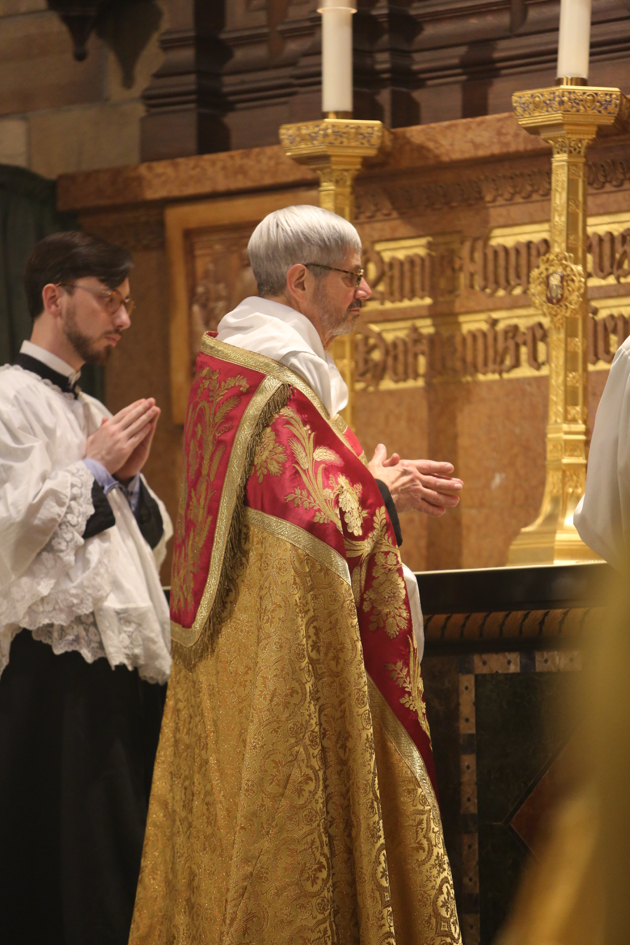
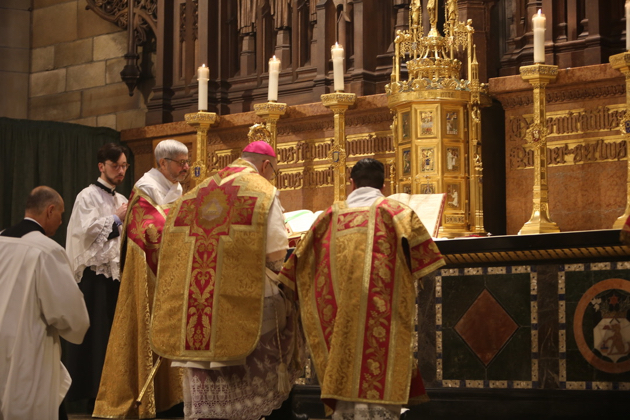
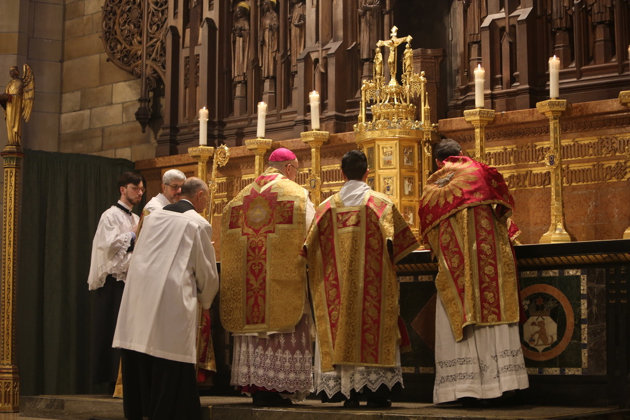

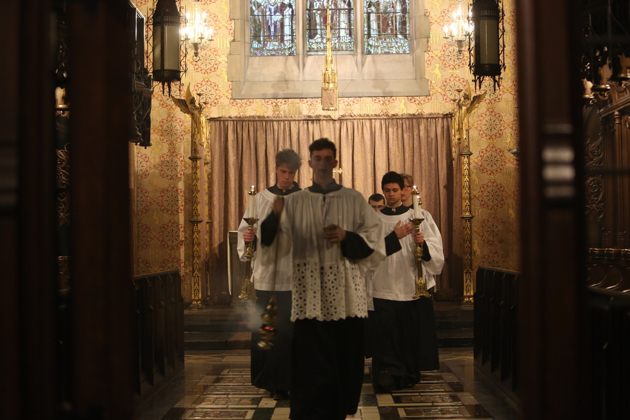

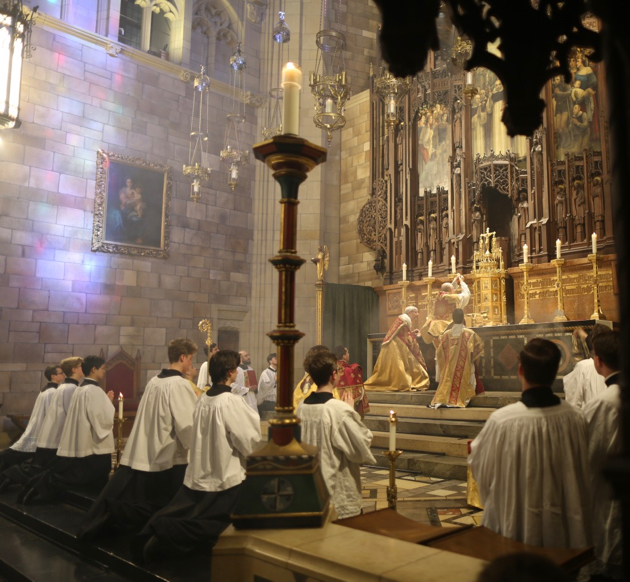
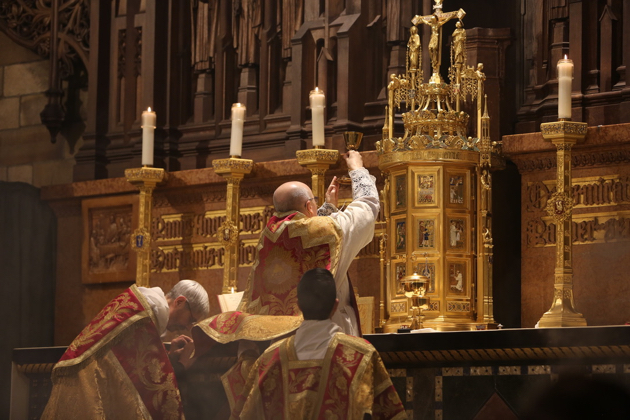
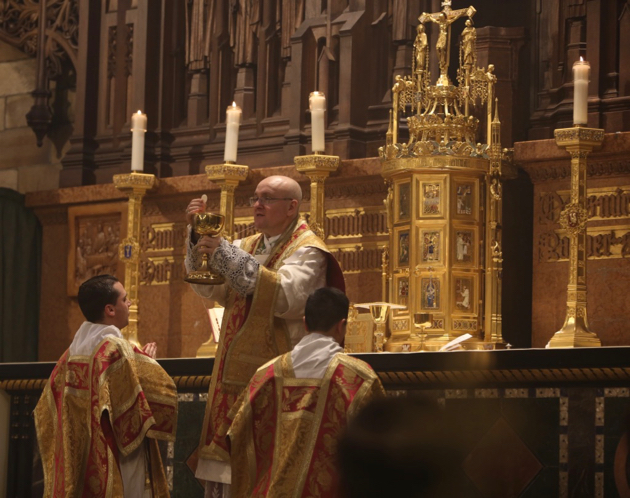

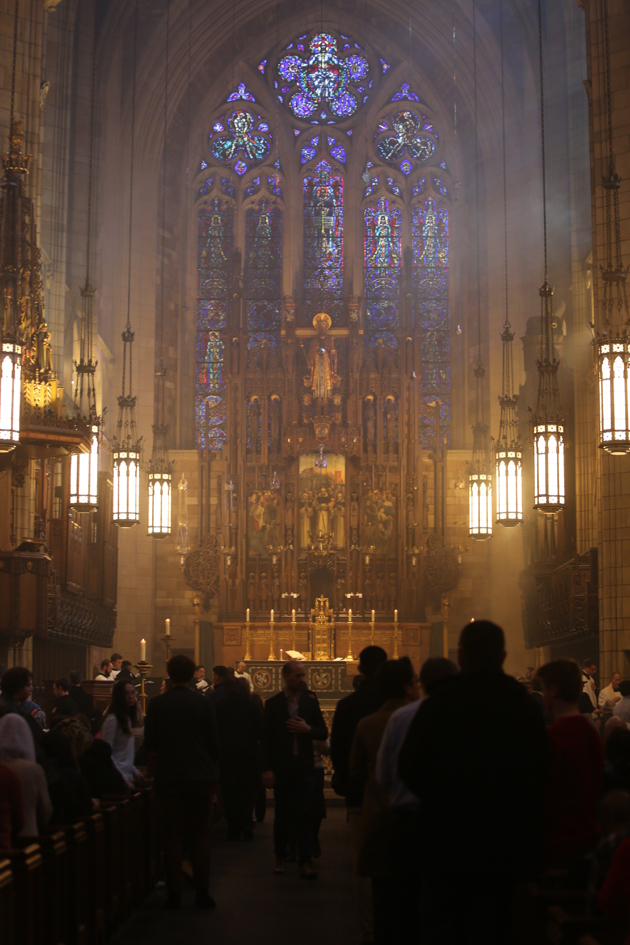
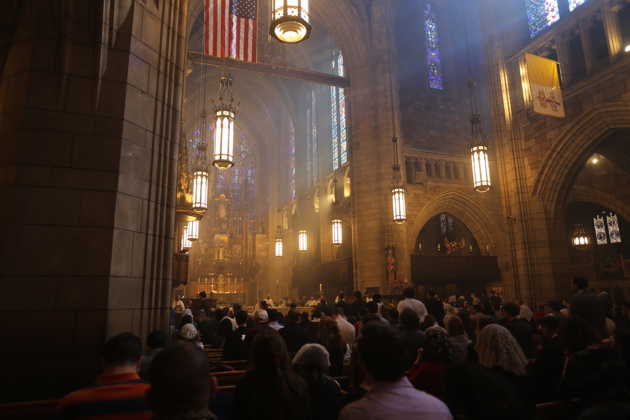


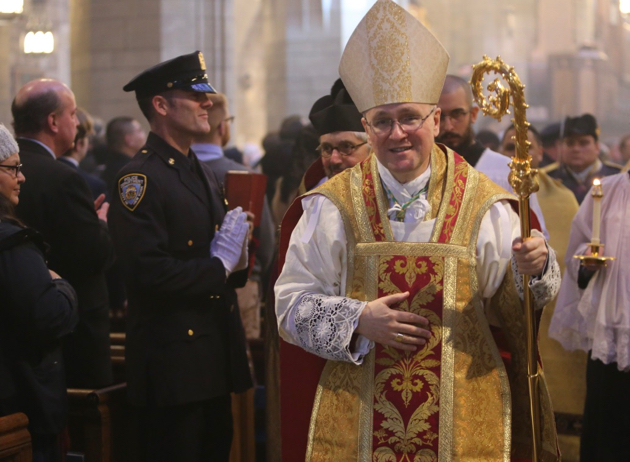
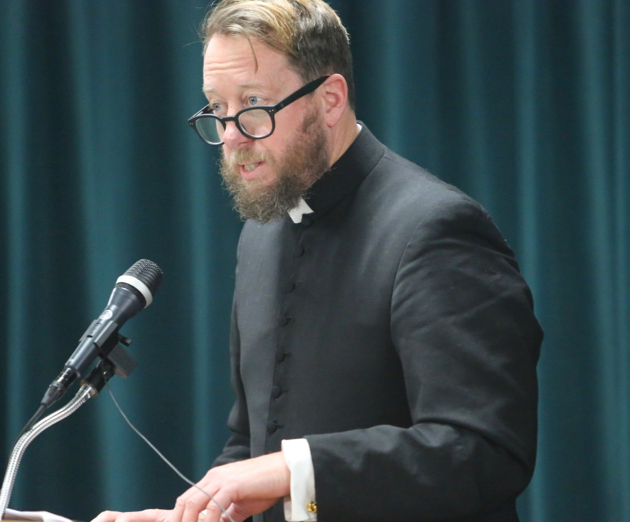
Fr. Kevin Cusick expertly moderated the conference.
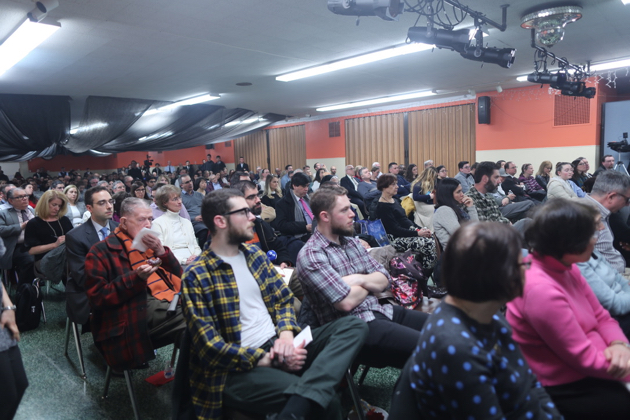
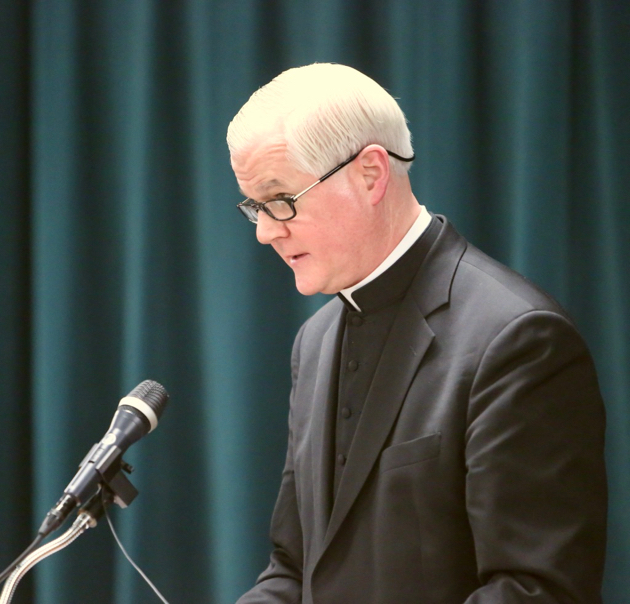
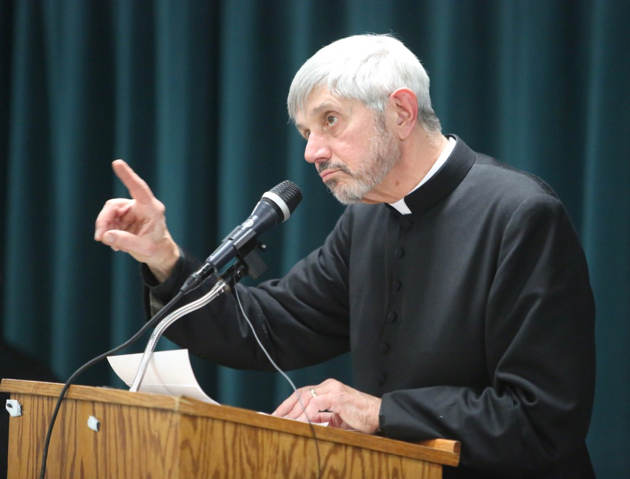
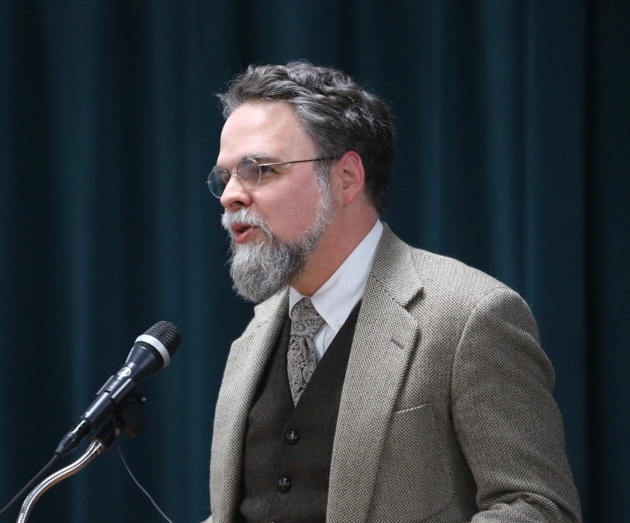
17
Feb

The Second annual Lepanto conference took place Saturday amid the Gothic splendor of St Vincent Ferrer church in New York. I estimated that 700 were in the congregation for the Pontifical Mass; some 315 attended the conference itself. Thanks are due to Fr Walter C. Wagner OP, the pastor of St Vincent’s and to the Dominican order for hosting the conference.
The Most Reverend James Massa, auxiliary bishop of Brooklyn, celebrated Solemn Pontifical mass for St Pius V – the codifier of the Traditional Roman liturgy. Fr Richard Cipolla, of the Bridgeport diocese, was assistant priest. Rev. Mr Roger Kwan (Archdiocese of New York) served as deacon; Fr. Sean Connelly (Archdiocese of New York) was the subdeacon. William Riccio and Steve Quatela were the masters of ceremonies.
The Society of St Hugh of Cluny was proud to sponsor this event. The generosity of the late Fr. Ignacio Barreiro sponsored the memorable divine liturgy.

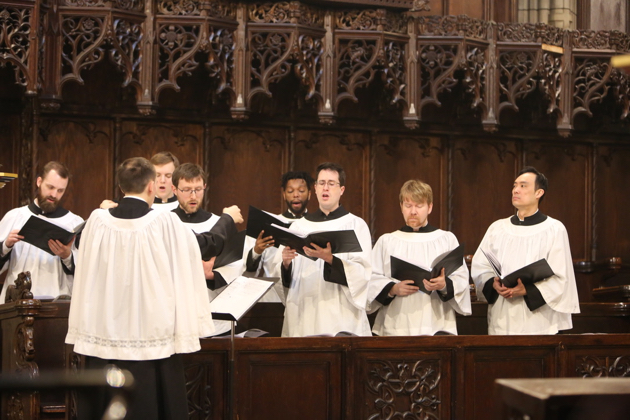
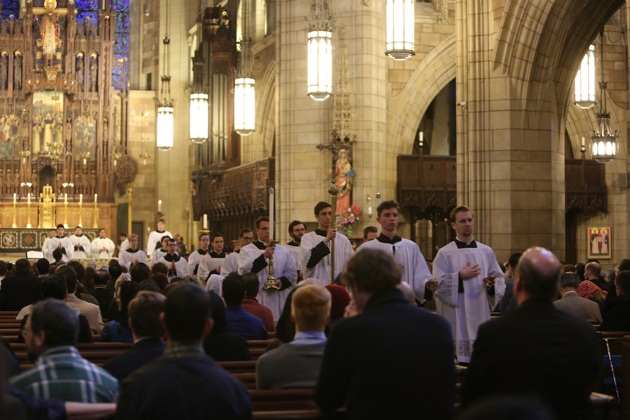
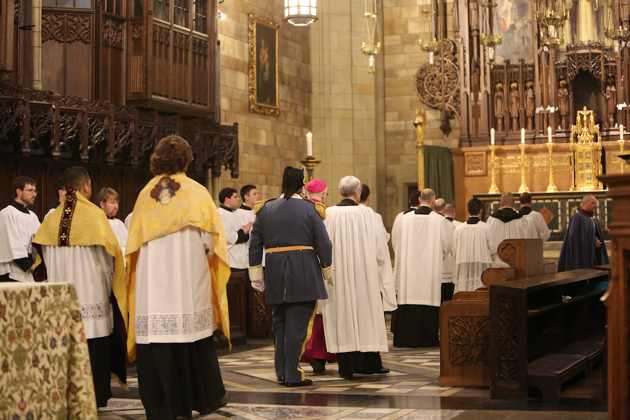
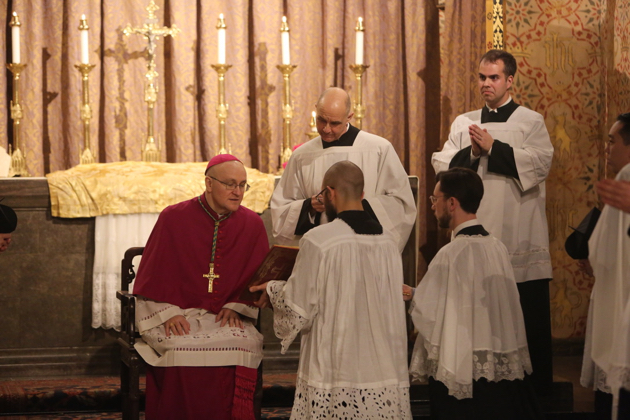

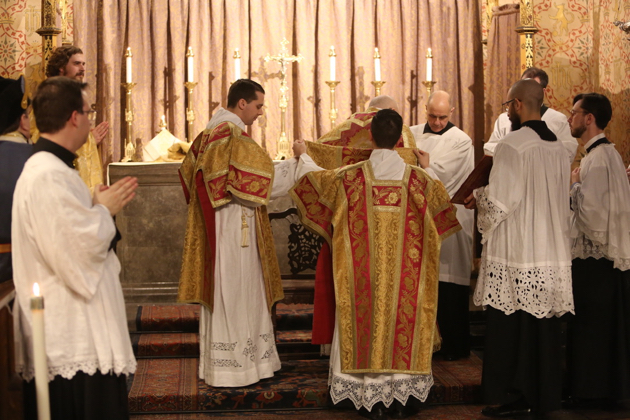
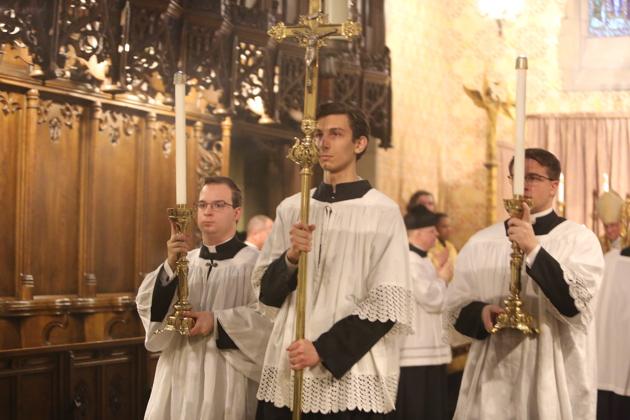
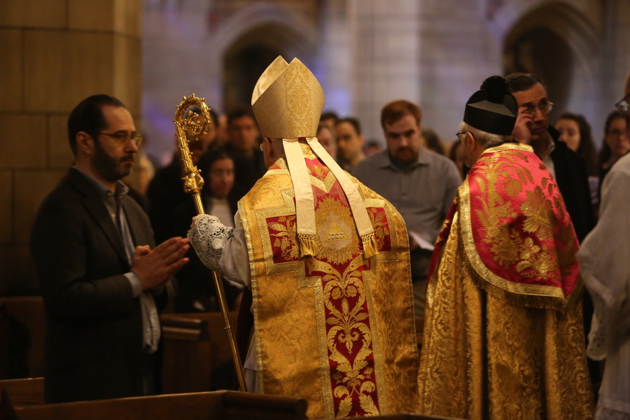

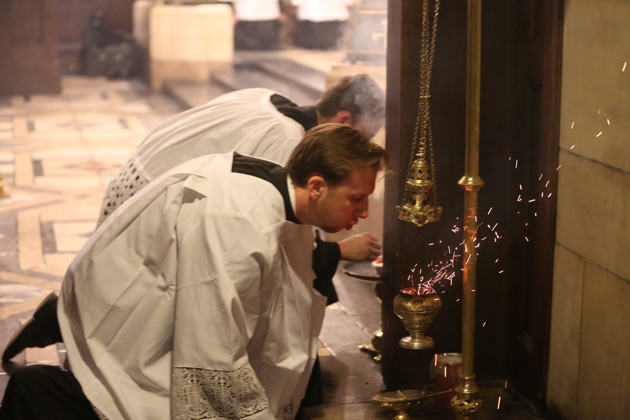
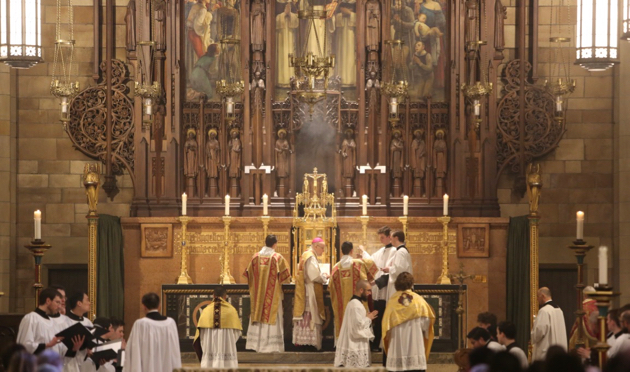



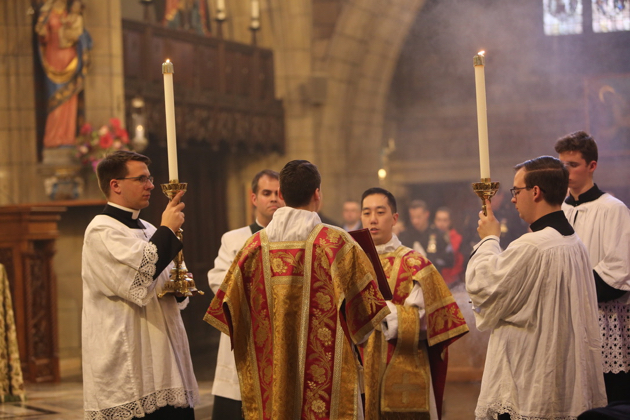
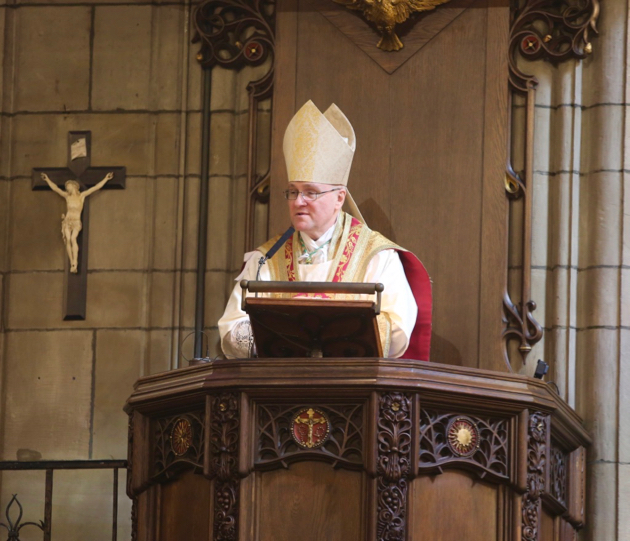
17
Feb
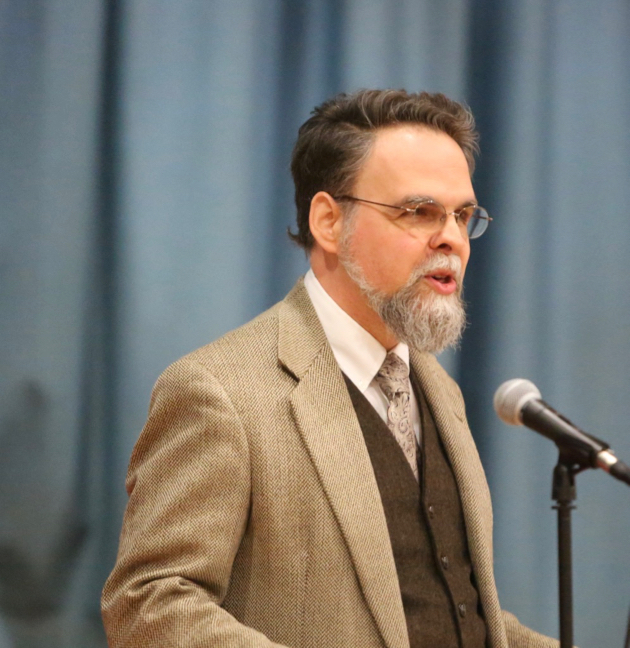
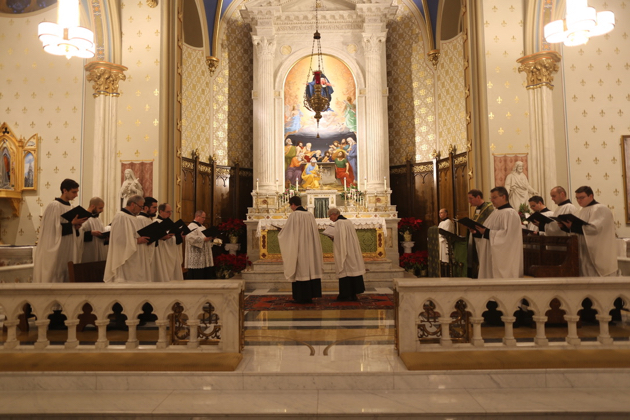

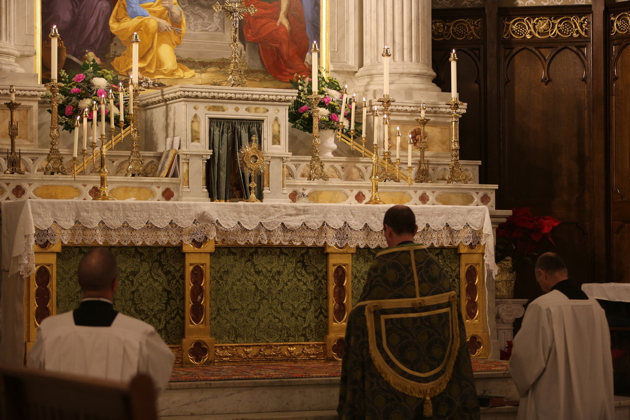
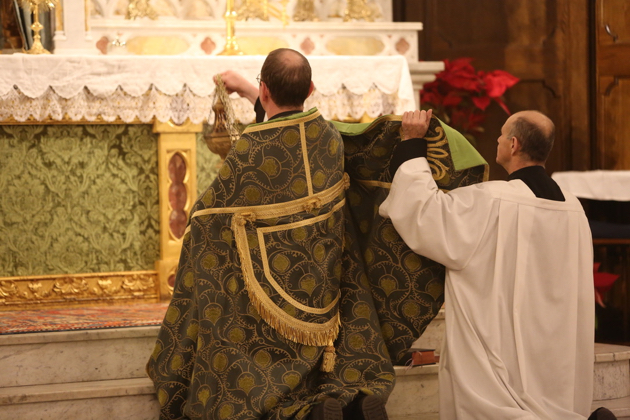

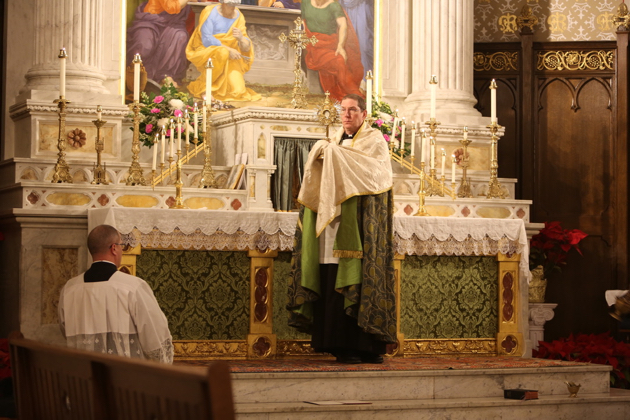
16
Feb
Talk by Fr Richard Cipolla at the Lepanto Conference
February 16, 2019, St. Vincent Ferrer Church, New York
“Rage—Goddess, sing the rage of Peleus’ son Achilles, murderous, doomed, that cost the Achaeans countless losses, hurtling down to the House of Death so many sturdy souls, great fighters’ souls, but made their bodies carrion, feasts for the dogs and birds.” So begins, in the English translation by Robert Fagles, one of the seminal epic poems of Western civilization
The Iliad. The first book is called The Rage of Achilles, Achilles, the son of a goddess, fierce, the ultimate war hero and yet, in Fagles’ words in his introduction to the Iliad, “imprisoned in a godlike, lonely, heroic fury from which all the rest of the world is excluded.” Achilles sits out most of the Iliad and returns to action so to speak only when his friend, Patroclus, whom he loves so deeply, is killed and despoiled by the Trojan Hector. And it is then that Achilles becomes the killing machine not so much for the cause of the Greeks against the Trojans but rather because of his rage against Hector, a hero in in his own right, for killing and despoiling Patroclus. And in that terrible scene we know so well, he kills Hector and drags his body around the walls of Troy three times in uncontrollable fury. He rises as a hero to avenge the death of his beloved Patroclus, and he is godlike in his single mindedness to punish at all costs the one and those who have taken away someone that he loved deeply. Heroism as singlemindedness, as physical prowess in war, as exhibiting passionate emotion, and heroism as knowing as well that one is doomed to death by the botched attempt of a god to make him immortal.
Arma virumque cano. So begins the Aeneid, Vergil’s epic poem about the trials and tribulations of the founding of Rome by Aeneas, a fugitive from Troy who witnessed the destruction of that great city.” I sing of arms and the man.” I sing of war and the man, the man who is the hero that makes possible not only the founding of Rome but who is the personification of the ideal of Roman civilization. One sees clearly at the start that this hero, Aeneas, is quite different from Achilles. We first see Aeneas, or meet Aeneas, not in a sulking rage in his tent, refusing to fight for the Greeks. We first meet Aeneas on a ship in a storm, a storm whipped up by the orders of Juno, the goddess queen, who fears the founding of Rome and does everything she can to stop it. The first speech of the hero, in the translation by Robert Fitzgerald, as the hurricane threatens the lives of everyone on board ship.
“Aeneas on the instant felt his knees go numb and slack, and stretched both hands to heaven, groaning out: Triply lucky all you men to whom death came before your fathers’ eyes below the wall at Troy! Bravest Danaan, Diomedes, why could I not go down when you had wounded me and lose my life on Ilium’s’ battlefield!” This hero is not Achilles. He is terribly frightened and wishes that he had died defending Troy instead of dying of drowning at sea. Not a good introduction to a hero, the hero who would lay the foundations for the founding of Rome and the Roman civilization that left its mark even after its fall on the way to that Western civilization that developed impregnated with the Christian faith. Aeneas is the first modern hero, that is, the hero as flawed, son of a goddess but very human indeed, with glaring faults that include a forgetting of who he was and what was his calling. That forgetfulness defines in many ways Western man through history, which deliberate forgetfulness is the mark of modern and post-modern man. Modern man deliberately forgot his roots. Post-modern man has little clue of his roots. Aeneas forgets his calling to found Rome when confronted with the very special woman that is Dido. Dido as a real and persuasive temptation, a great woman, for Aeneas was very real and perfectly understandable. It was the temptation to become settled down and ordinary with an extraordinary woman. It took a hair -raising visit from Mercury, from the gods, to jolt Aeneas to remember his destiny.
Vergil describes Aeneas many times by using the adjective pius. This adjective becomes almost part of his name: pius Aeneas. This adjective cannot be translated by the English adjective “pious”, especially in a time when piety is not seen as something entirely positive even in the Catholic Church. Piusmeans something clear: devotion and allegiance to the gods, to one’s family and to one’s country, patria. Aeneas’ obvious love for his comrades, his taking on the burden of his calling, his appreciation of lacrimae rerum,the tears of things that lie at the heart of the human experience, his face of optimism and hope that he presents to his comrades when he weeps and is afraid in his heart, his positive self-forgetting within his special vocation, this ispius Aneas. Even when in the last books of the Aeneid Aeneas become a fighting machine like Achilles, his pietasis not lost. To see that pietas in marble one must go to the Galleria Borghese in Rome and see one of the earliest of Bernini’s sculptures that depicts Aeneas fleeing the destruction of Troy, carrying his aged father, Anchises, on his back, his father holding the household gods, Aeneas holding the hand of his little son Iulus, as they go forth from burning Troy to the unknown that is known as his destiny.
I would submit, willingly accepting the arrows of historicists and current despisers of Western culture, that Roman pietas was transformed into Catholic pietasnot as a merely human development but rather as the result of the thunderclap of the Incarnation that transcended and fulfilled not merely the longing of the Jews but also the dogged if also unclear and flawed longing of the Roman understanding, despite its warping through the years of Empire, of pietas: love of God, love of family and love of one’s country, the latter understood as something that transcends mere nationalism.
One either believes that the Incarnation of God in Jesus Christ in our time and space radically changed the very nature of things, changed time and space itself in relationship to human beings, such that after the Incarnation time is no longer linear but spherical, with the Incarnation at its center—or not. If not, Christianity is mere religion, one religion among many and in the end—a currently common opinion in Rome—it makes no difference what one believes because the God who is the Wizard of Oz has many tracks on his choo- choo train, and everyone ends up in the same wonderful place that is a projection of each individual’s picture of happiness. But against this false and facile and foolish version of Christianity there are the saints: the Christian heroes who are products of the big bang of the Incarnation. The Christian heroes are a problem for those who would reduce Christianity to mere moralism, to being kind and good, and let others be kind and good in their own way without any reference to faith or belief.
The Latin word virtusis the origin of the English word, virtue. Once a powerful word in the English language, virtue as a word now appears only in tony BBC remakes of Jane Austen novels or in homework assignments for Catholic boys and girls studying for the test that will allow them to be confirmed. Imagine a sacrament depending on passing a test! The first meaning in Latin ofvirtusis the obvious one: the quality of the man-hero, the vir The secondary meanings are strength, courage, bravery, and in the Christian era, virtue. The saints remind us that one cannot have virtue in the deepest sense without being strong, without having courage, without being a hero. And—here comes the pedantry of the Latin teacher—the word virtusin Latin is feminine. Those of us who celebrate the Traditional Mass as the heart of our priesthood know deeply the virtusof Felicitas, Perpetua, Agatha, , Lucia, Agnes, Cæcilia, Anastasiaand all the saints. The quality ofvirtustranscends both sex and gender. Speaking of gender, I used to tell my Latin students when the whole question of the deliberate mis-use of the word gender in our culture came up in class: nouns have gender, people have sex. If your parents had gender and not sex, you would not be here today.
I shall briefly offer three Christians as examples of a Christian hero. One must understand essentially that what sets them apart from heroes in general is that the heart of their heroism is not an idea or an ideal but rather a person, and this person is Jesus Christ, born of the Virgin Mary, suffered under Pontius Pilate, was crucified, died and was buried and on the third day rose from the dead. What makes the Christian hero is not merely pietasor bravery or a shining example of virtue. What makes the Christian hero is the person of Jesus Christ and the imitation of Him.
The first is Saint Paul, for me almost the very definition of the Christian hero. It is perhaps unfair to offer him as an example because he is so singular in so many ways. Who else was knocked off his horse as he, a Pharisee, was traveling to persecute Christians, knocked off in such a dramatic way that leaves nothing to the imagination, as painted by Caravaggio and seen in Santa Maria del Popolo in Rome? St. Paul, like all Christian heroes, is not perfect, he is flawed. His letters betray his disappointment and frustration with those in the churches to whom he writes and which he visits, who do not understand what it means to be a disciple of Christ and what this means for one’s life. He is sensitive about his own calling as an apostle. Unlike Peter, whom Jesus made the rock in his living presence, with all that means and does not mean, Paul is called late in time and never knew Jesus as he walked this earth, and that causes conflict for him in his own self-understanding and certainly in his relationship with Peter. But when one reads Paul’s letters, it is absolutely clear that he understands that the person of Jesus Christ is the heart of his existence and that he believes that Christ is the Savior of the world, not merely of Jewish converts, but of the whole world, and this faith drives his missionary journeys replete with shipwrecks and beatings and imprisonment, and the writing of his letters to the various churches throughout the Roman empire–without which there would be—bold statement coming—no Christianity. And it is Paul who understands that the ultimate imitation of Christ in the world is to die for Christ, and it is this imitatio Christithat fuels his heroism and makes him a Christian hero.
The second is St. Ignatius of Antioch. I first met this Christian hero in the Bodleian library at Oxford University. I was doing my doctoral thesis on the history and development of the doctrine of Transubstantiation in the Church. I knew I had to read Ignatius’ Letter to the Romans. My Greek was not great, and I remember sitting there in the dreary English damp cold struggling through the text. And then I came upon this passage.
I write to the Churches, and impress on them all, that I shall willingly die for God, unless you hinder me. I beseech of you not to show an unseasonable good-will towards me. Allow me to become food for the wild beasts, through whose instrumentality it will be granted me to attain to God. I am the wheat of God, and let me be ground by the teeth of the wild beasts, that I may be found the pure bread of Christ. Rather entice the wild beasts, that they may become my tomb, and may leave nothing of my body; so that when I have fallen asleep [in death], I may be no trouble to any one. Then shall I truly be a disciple of Christ, when the world shall not see so much as my body. Entreat Christ for me, that by these instruments I may be found a sacrifice [to God]. I do not, as Peter and Paul, issue commandments unto you. They were apostles; I am but a condemned man: they were free, while I am, even until now, a servant. But when I suffer, I shall be the freed-man of Jesus, and shall rise again emancipated in Him. And now, being a prisoner, I learn not to desire anything worldly or vain.
All the pleasures of the world, and all the kingdoms of this earth, shall profit me nothing. It is better for me to die on behalf of Jesus Christ, than to reign over all the ends of the earth. For what shall a man be profited, if he gain the whole world, but lose his own soul? Him I seek, who died for us: Him I desire, who rose again for our sake. This is the gain which is laid up for me. Pardon me, brethren: do not hinder me from living, do not wish to keep me in a state of death; and while I desire to belong to God, do not give me over to the world. Allow me to obtain pure light: when I have gone there, I shall indeed be a man of God. Permit me to be an imitator of the passion of my God. If any one has Him within himself, let him consider what I desire, and let him have sympathy with me, as knowing how I am straitened.
I stopped reading. Ignatius’s words, his faith in the person of Jesus Christ and his faith in the real presence of this person in the Eucharist stopped me cold. And in retrospect this was an important event that led me to the Catholic Church. But not only his belief, in the second century, in the Real Presence but his understanding that the ultimate imitatio Christi is martyrdom made me understand for the first time the essence of the Christian hero: the imitation of the ultimate self-giving of the Son of God, martyrdom as the ultimateimitatio Christi. It is certainly true that many men and women through the past two millennia have had the imitation Christi at the center of their lives and have imitated Christ in the way they lived their lives: subordination of the self by the act of self-giving love. But it is martyrdom for the sake of Christ that is the ultimate crown. Again, it is not merely a desire for martyrdom. The Christian desire for martyrdom is driven by love, a love for those to whom Ignatius writes his letters on his way to Rome, those who lived in fear of persecution everyday. And his love for his flock in Antioch as bishop and his concern for those living in cities on his way to Rome. The foundation for this loving concern is the person of Jesus Christ whom he knows and therefore loves.
The third is Joan of Arc. Her presence in my life of faith is recent. Some years ago while rushing through the later European paintings in the Metropolitan Museum of Art in New York on my way to some painting deemed very important to the Met collection, I walked by a painting by an artist of the later nineteenth century, French, that I had never heard of. I stopped and looked and was mesmerized. The painting is strange, quite rightly, because Joan hearing the voices of the three saints calling her to her peculiar mission, is strange, the intensity of her listening face, the mysterious crudity of the painting of the three saints, the almost alarming clarity of her surroundings: I said to myself: why do I not know this woman? I knew about her vaguely from history books, strange young woman, dressed up in armor like a man and led an army to rid France of the English enemy, was burned at the stake in Rouen, all these facts. I knew she was a saint but only recognized as such by canonization as late as the second decade of the 20thcentury. I read about her from various sources, and then I hit upon her biography in novel form by Mark Twain. Mark Twain! One of the great skeptics of any religion. What Twain saw in her was the truth about Joan of Arc. He was able to detach from her particular situation, her sitz im lebenat a particular time and place , to see her as a true hero who transcended her time and place, and Twain knew, even if he did not understand, that what drove her to don her armor was not merely because she was the maid of Lorraine who heard these voices of the saints but because of her Catholic faith that exemplified itself in her pietas, part of which washer love of her country and its Catholic faith. The peasant girl who did what no man could do for years, to lift the siege of Orleans and to go on to make it possible to have Charles VII crowned as king of France in Rheims. Surely this woman echoes the words of John of Austria’s words to his men about to do battle with the Ottoman fleet off the coast of Greece at Lepanto:: There is no paradise for cowards. Joan of Arc was betrayed, betrayed by her countrymen and her Church. She was totally abandoned by those she fought for and in a horrendous mock trial led by a faithless bishop she was stripped of the very heart of her singular and in some ways incomprehensible quest, and she was burnt at the sake in a public square in Rouen. One wonders, despite her canonization 500 years after her death, whether the irony of Joan’s martyrdom was ever understood by the Church. Probably not, for she, as so many other Christian heroes, has faded into that place where the names of saints are mere names, nomina nuda, verba nuda.
Shortly after the movie, The Graduate, became a big hit in 1967 and the song from that film, Mrs Robinson , became a hit as well, Paul Simon happened to meet Joe Dimaggio who somewhat testily asked him why he wrote those words, “Where have you gone, Joe Dimaggio.” Simon, in his retelling of this meeting, was taken aback and really could not answer. That further refrain in the song: Jesus loves you more than you can know. Where did that come from? The sixties were that time of transition from modern to post-modern, a time of social upheaval, a time of challenging deeply the basic assumptions and mores of a Western culture that was permeated by Christian faith. And sadly and ironically, that was exactly the time that the Catholic Church decided to become modern, when the rest of the Western world was abandoning modernity. It was not being abandoned for the sake of turning to the Catholic faith to be sure, but rather for a post-modernity that has little interest in the modern world, the latter world formed at least symbolically by the so-called Enlightenment and which crumbled under the onslaught of two terrible World Wars. The tragedy associated with the Second Vatican Council is not the Council itself, for many Ecumenical Councils contributed little to the ongoing faith of the Church. Most Councils contributed just what they had to, no more, no big deal. The tragedy of the Second Vatican Council is not merely Councilolatry, worship of the Council, nor its adopting the false confidence of the revolutionaries who were convinced that they were ushering in a new world in which all you need is love. The real and deep tragedy of the Council is its still -born attempt to make Catholic worship modern, imposing forcibly on the whole Catholic Church, like the Protestants at the English Reformation, a liturgy that is redolent of a progressive looking but terribly sentimental sitcom of the 60s and 70s that now has little relevance to contemporary man and even less relevance to the worship of the Church within the God-given Tradition of the Church, and whose bitter fruit is the fact that at least in the Western world an average of only 20% of Catholics attend Mass on a Sunday.
The Greek word doxa in classical Greek means common belief or popular opinion. Sophocles famously rejected doxa as understood in this way as the basis of truth. But many centuries later, the translators of the Septuagint translated the Hebrew word for “glory’, as in the glory of God, asdoxa. It is this word that permeates the New Testament with respect to the glory of God, and, not insignificantly, the book of Revelation, the vision and handbook so to speak of the eternal worship of God in heaven. What this means is that one cannot separate true worship, how one worships God, from true doctrine, what is to be believed as true. True and good worship of God brings forth and supports the truth of dogma, and this is true certainly in the development of doctrine. The form of worship, the liturgy, that departs from the bond between the truth of doctrine and the truth of worship within that special Holy Spirit led reality that is Catholic Tradition, must in the end dissolve both worship in spirit and truth and the very idea of orthodoxy as what is to be believed.
The heroes of the Church of the immediate and near future will be those Catholic men and women, lay, priests and bishops, who will understand that the fruit of wrong worship is wrong theology and wrong living. A liturgy made up after the Council by a committee called a Consilium( some members of which openly despised the Roman Mass) at a certain time and place in the history of the Church, a liturgical rite concocted on the basis of liturgical scholarship du jour and personal preferences, a liturgical rite that is a break with the Tradition of the Church, cannot provide the spiritual nourishment that will enable Catholics in the future to be Christian heroes. And without Christian men and women as Christian heroes the scandal and wonder of the Incarnation will no longer be known. Without Christian heroes the centrality of the Cross of Jesus Christ to the meaning of the suffering of the world will be lost. Without Christian heroes the reality of the promise of eternal life in Jesus Christ will be lost. But there are young people here and in many places who understand what it means to be a Catholic and who have discovered the Traditional Roman Mass and who are willing to be Christian heroes, even if it means in some real way to walk the way of the Cross, especially within a Church whose leaders have deliberately forgotten what it means to be a Christian hero and who seem hell bent to make the Catholic Church into a form of Anglicanism except without good taste.
Where have you gone, Joe DiMaggio
Our nation turns its lonely eyes to you
Wu wu wu
What’s that you say, Mrs. Robinson
Jolting Joe has left and gone away
Hey, hey, hey, hey, hey, hey
Or this:
Bring me my Bow of burning gold:
Bring me my arrows of desire:
Bring me my Spear: O clouds unfold!
Bring me my Chariot of fire!
I will not cease from Spiritual Fight,
Nor shall my sword sleep in my hand:
Till we have restored the worship of God,
In every Catholic Church in ev’ry land.
Contact us
Register
- Registration is easy: send an e-mail to contact@sthughofcluny.org.
In addition to your e-mail address, you
may include your mailing addresss
and telephone number. We will add you
to the Society's contact list.
Search
Categories
- 2011 Conference on Summorum Pontifcum (5)
- Book Reviews (96)
- Catholic Traditionalism in the United States (24)
- Chartres pIlgrimage (17)
- Essays (176)
- Events (670)
- Film Review (7)
- Making all Things New (44)
- Martin Mosebach (34)
- Masses (1,343)
- Mr. Screwtape (46)
- Obituaries (15)
- On the Trail of the Holy Roman Empire (22)
- Photos (347)
- Pilgrimage Summorum Pontificum 2021 (7)
- Pilgrimage Summorum Pontificum 2022 (6)
- Pilgrimage Summorum Pontificum 2023 (4)
- Sermons (79)
- St. Mary's Holy Week 2019 (10)
- St. Mary's Holy Week 2022 (7)
- St. Mary's Holy Week 2023 (7)
- St. Mary's Holy Week 2024 (6)
- Summorum Pontificum Pilgrimage 2024 (2)
- Summorum Pontificum Pilgrimage 2025 (7)
- The Churches of New York (198)
- Traditionis Custodes (49)
- Uncategorized (1,377)
- Website Highlights (15)
Churches of New York

Holy Roman Empire

Website Highlights
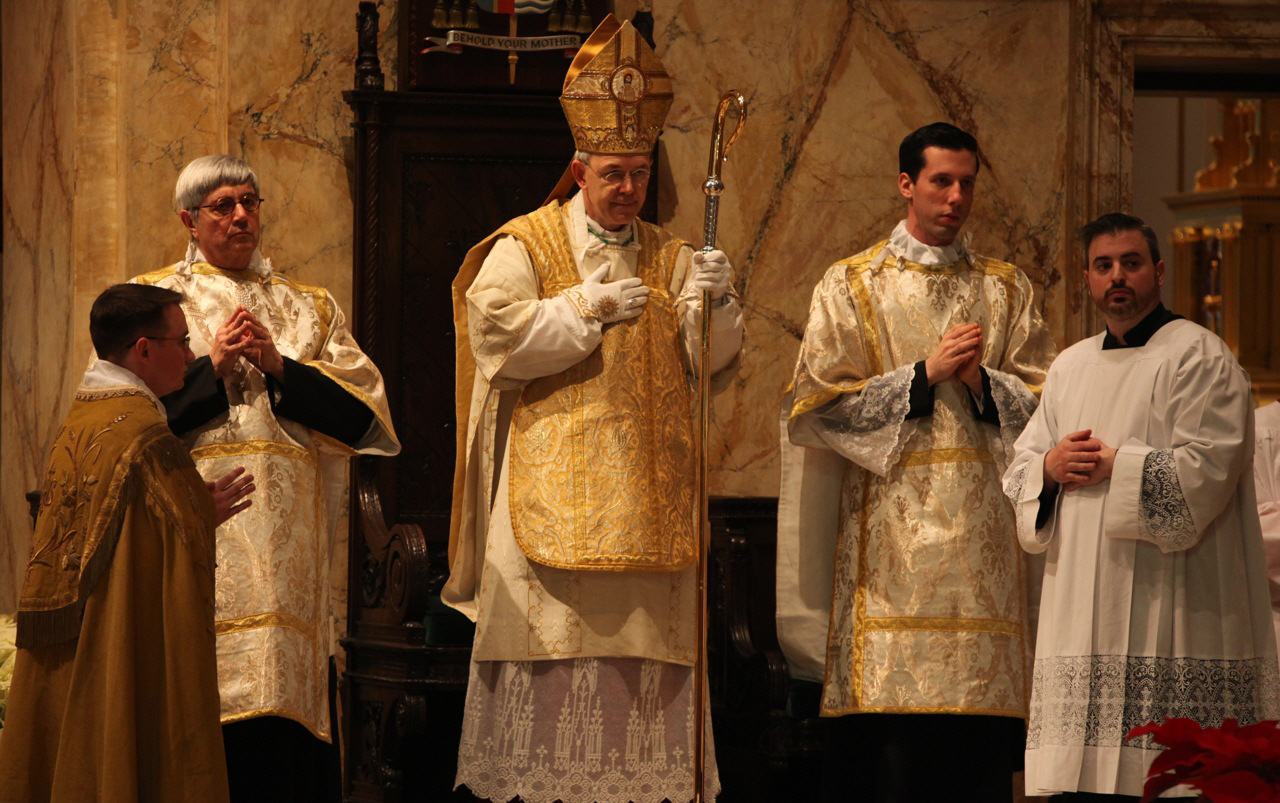
Archives

[powr-hit-counter label="2775648"]
